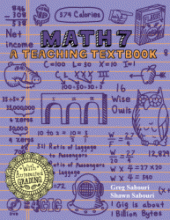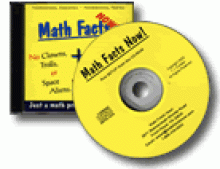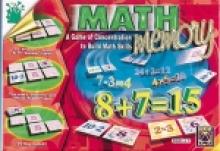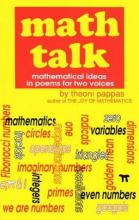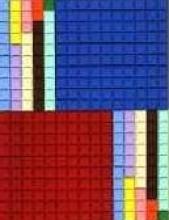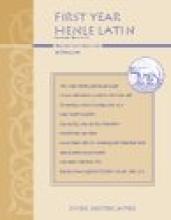No name
Math 7: A Teaching Textbook
Also includes answer key and 4 CD Set
Purchasers of the original CD edition, which contained several errors in the solutions, can exchange them for corrected CDs. Please contact Teaching Textbooks (customerservice@teachingtextbooks.com).
Math Facts Now!
Advertised as "No Clowns, Trolls or Space Aliens...Just a math program that works!", this program really is just a simple way of drilling math operations. A simple menu allows you to choose your operation, number of problems to solve and how much time to do it in. You can even write in a reward that will be offered when the child achieves at a certain level!
My nine-year-old son really loves this program. He says he likes being able to choose the operation and doing some of his Math without having to write everything out. He basically thinks it's fun time on the computer, but I know that he's learning his math facts too.
Version 2.0 for Windows 2000, ME, XP, Vista and 7.
Website: https://tablefacts.com/
Math Memory
Creative Toys, 1997, 140 study cardboard cards in a standard game box
This is a fun and well-made math version of the classic Memory game. Instead of finding matching pictures, children match equations with answers. (Equation cards and answer cards look different on the backs so you can select one of each.) The answer cards have a sample equation for each operation printed in the corners. Equations are color-coded according to operation so you can easily sort out ones that you aren't currently focusing on (it's also a little difficult to use all the cards at once - there are so many!)
Math Talk
I have long been a fan of the poems for two voices books by Paul Fleischman. This book puts a twist on the idea by covering math topics in poems. It's a really unique and engaging way to memorize a math concept, reciting it as a poem. A poem for two voices is a poem recited by two people where sometimes the same words are said in tandem, sometimes alternately, and sometimes, the speakers speak at the same time saying different things.
Here is a sample of part of a poem from the book: (The first column is the first speaker and the second column, the second - shown smaller than actual size) 
Some of the math concepts in the poems are fairly simple ideas that would pertain to a grammar school student, however most of the ideas are for middle schoolers or high schoolers. There were a few math concepts I had never heard of, such as fractals, (the geometry of nature), Fibonacci numbers (adding the last two numbers in a series to give the next number), and Mobius strips (circular strip with a twist in it).
While you don't learn everything you need to know about the math concepts in the poems, you get an introduction to the idea and the basic or interesting facts. For tessellations, the reader learns that not all figures tessellate; for triangles, the reader learns that the angles in the figure must equal 180 degrees. Some of the accompanying illustrations are also instructive. I could not have visualized the Mobius strip without the drawing of it.
This is a fun way to talk about these concepts. Trying to say the poems as a team takes a lot of concentration and brings a lot of laughs along the way. The book would make a great addition to a living math program or be a nice break from a formal textbook program.
Recommended for grades 4-12
Math-terpieces
Perusing through the Math titles in Picture Books at the library last week I found lots of books. Alas, most of them were, well, boring. Uninteresting. I brought a handful home to investigate and of those I found a few nice volumes including this one!
I love almost anything that is integrated with Art. (Well, almost anything.) My younger homeschool students are all artistically oriented and if I integrate a subject with Art I get smiles. I am doing just that with History this semester with happy results: I provide a workpage with a theme and examples to be created and colored artistically for each chapter of Seton's The Catholic Faith Comes to the Americas.
This is a simple Math book for young ones: from each famous painting the clever illustrator took one element and displayed it on the facing pages in different sizes, colors, and groups. By grouping the elements in different ways, young Math students have a peek into the world of addition, multiplication and beyond. On the side, they will enjoy a quick tour of the art world in chronological order and some cute rhymed lines as well!
Math-U-See
Math-U-See is a fairly new Math program, designed especially for homeschoolers, which runs from Kindergarten all the way through high school. The author is a former high school Math teacher who has attempted to balance a solid conceptual understanding of math with enough practice to let it "sink in." The program consists of a student text (workbook format), a teacher's manual, and optional practice sheets, special Math-U-See blocks and a teacher training DVD. I am very impressed with this program. The author does a fine job of allowing the students to become well aquainted with using numbers. I found math concepts very easy to explain to my daughter with the use of the very clever manipulatives (which might be thought of as a cross between "Base-ten Blocks" and Cuisinaire Rods). I was particularly impressed with how clearly place value is taught and how thoughtfully the child is prepared for future lessons (e.g. early on in addition, the child starts doing simple "solve for the unknown" problems in preparation for subtraction). Other skills learned include telling time, measurement and a heavy emphasis on skip counting (in preparation for future multiplication and factoring). My only complaint is that some of the material is contained only in the teacher's manual (I can imagine that this might have been done intentionally to force the parent to follow along in the teacher's manual rather than letting the child work entirely on their own. The author demonstrates how each concept works on the DVD so that the parent may more confidently teach the concept to the child.
Over the years we haven't always used Math-U-See as our primary Math text, but we have always found the DVDs and blocks useful no matter what we were using.
Meat & Potatoes Catholicism
Ordained in 2003, this is Fr. Classen's second book published by Our Sunday Visitor.
Meet the Masters
Years ago, a friend who teaches university-level art classes, told me that the best way for me to teach my children art was to combine how-to instruction with art appreciation. She suggested learning about the life of a particular artist by reading biographies and then learn how to imitate his or her technique. This made perfect sense to me, but I did not feel knowledgeable enough in the subject matter to put together my own curriculum and I did not know of any such art program that could be used in the home.
Enter Meet the Masters. This program integrates how-to instruction with art appreciation.
To review Meet the Masters, I invited two other families to join me and my children in using the program, forming a co-op of sorts. My desire was to get a feel of the program myself, as well as see how other families responded to the instruction. I am happy to report that our little art co-op was very successful.
In the first lesson the children learned about the life of Vincent Van Gogh, through the CD-ROM that comes with the program and the Internet. All of the children gathered around me and the computer, as I read from the script that comes with the program. It is good that Meet the Masters provides scripted instruction, as my personal knowledge of famous artists is admittedly limited. I learned about the life of Van Gogh alongside my children.
After reviewing Van Gogh's biography, we moved to the dining room table where we learned about his art technique and the children could mimic it. The program provides careful instructions on how to help the children with the lesson. It also provides a supply list and set-up instructions, so I was well prepared before our friends arrived.
I enhanced the program a little by searching out more of Van Gogh's artwork on the Internet and even saved one of his paintings to use as "wallpaper" on the children's computer (just left-click on the picture). That way every time the children booted up the computer, they were treated to a beautiful piece of art. I also picked up a children's biography at the library.
We met with our friends every other week until the program was finished. During that time we learned about Mary Cassatt, Piet Mondrian, Pablo Picasso, Claude Monet, and Winslow Homer. My children and the children of my friends (ages seven to twelve) all enjoyed the program and were even heard speaking about things such as texture, complementary colors, contrast, and the such throughout the weeks. On more than one occasion, my children recognized, and were excited to see, prints of the artists that we studied while visiting friends' homes or the doctor's office.
Though I do like this program very much, I am disappointed at the high price tag. It is expensive and parents must weigh the benefits with the cost carefully. However, the publisher does offer a generous discount if customers order more than one grade level at one time. A computer with a CD-ROM and Internet access is necessary to use Meet the Masters.
Note: This review is a bit out-dated. You can look at their current offerings here: http://meetthemasters.com/
Memoria Press' Henle Latin Guides
Second volume published in 2003.

